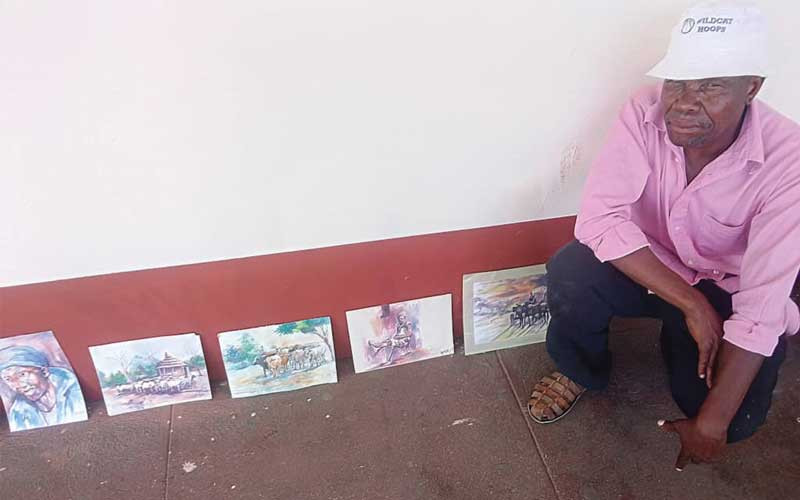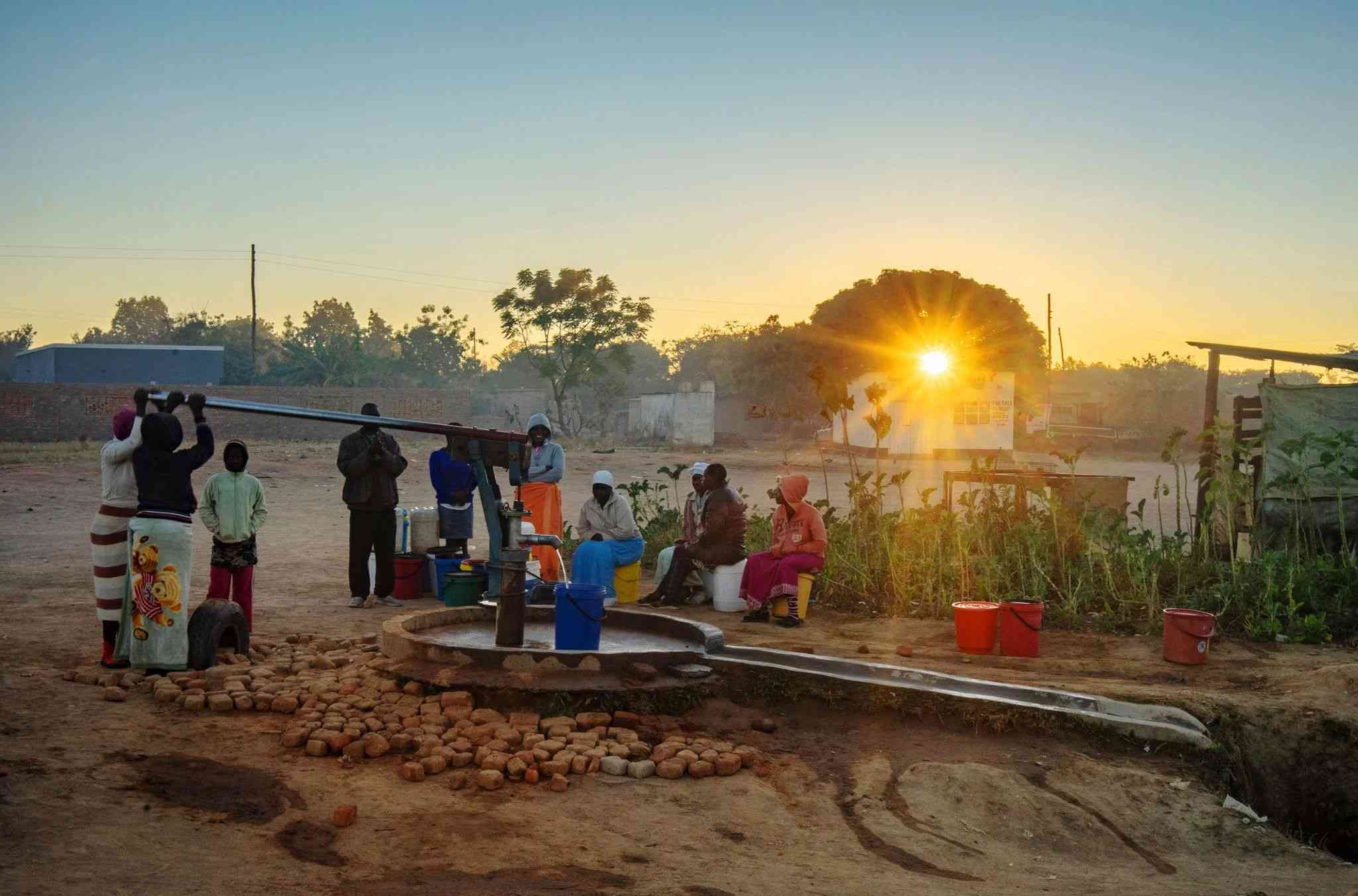
IN Zimbabwe's dire economic climate, where artists struggle to make a living from their art and craft, the streets have become a platform for showcasing talent. Coleti Dhlamini, a 62-year-old artist, is among those fighting for survival. For years, he has been a familiar face at the bustling Bulawayo Fife Street market, meticulously crafting and showcasing his artwork amidst the hustle and bustle.
Despite his talent and dedication, Dhlamini's masterpieces — ranging from pencil sketches to watercolour and acrylic paintings, seem to go unnoticed by the throngs of people rushing past.
His story is testament to the struggles of Zimbabwean artists, who face not only economic hardships, but a lack of appreciation for their work. In this feature we uncover factors that contribute to the low uptake of art in Zimbabwe, a country that is rich in creative talent. As we delve into Dhlamini's story, experts weigh in on the perceived value of art in Zimbabwean culture and the challenges facing artists in a struggling economy.
Dhlamini's journey as an artist commenced in 1979 at Mzilikazi Arts and Craft Centre (MACC) in Bulawayo. He enrolled at MACC intending to learn modelling, pencil drawing and pottery and soon realised that his talent was in drawing. " I enrolled at MACC with the intention to learn modelling, drawing and pottery, but l soon found my calling in drawing. I concentrated on water colouring, pencil shading and acrylic painting and did so well.
At this point l sold countless pieces of art to tourists from different regions of the world most notably Australia, Greece and Germany. I was also doing well on the local front where l landed big contracts from established businesses in the City of Kings like Palace Hotel. It contracted me to produce acrylic paintings to display in various sections of their hotel and l delivered. Around the same time, l also caught the attention of the late former president of Zimbabwe, RG. Mugabe and sold a piece of art framed around apartheid to him," said Dhlamini.
Dhlamini's career however, took a downward spiral when he left MACC after graduating. He joined forces with some fellow artists to form Art Root, a cooperative aimed at supporting creative and professional artistic development.
Five years later, the cooperative folded and that was when his journey as a solo artist started, that was when the struggle for survival commenced. "As a solo artist, it became difficult to find a market for my art. With no proper space to market my art, l found refuge on the streets of Bulawayo central business district.
While on the streets, it soon dawned on me that there was a general lack of appreciation for fine art by the public and that it was imperative for me devise other avenues to eke a living. I experimented with sign writing and realised that it actually had a bigger market in comparison to fine art. I automatically began to concentrate on sign writing and it is sign writing that landed me a job in Botswana," said Dhlamini.
- Mavhunga puts DeMbare into Chibuku quarterfinals
- Bulls to charge into Zimbabwe gold stocks
- Ndiraya concerned as goals dry up
- Letters: How solar power is transforming African farms
Keep Reading
Although he was working as a signwriter in Botswana, Dhlamini did not wholly suspend his art craft. He kept on painting, colouring and shading and would find strategic places to sit and market his art in Botswana most notably at Game and City Mall or by Bull and Bush pub. Through these avenues he managed to get notable contracts.
Through marketing his art at Game City Mall, one day a white man who owned an Abbattoir in Lobatse contracted him to produce a water colour piece of art depicting cattle on a farm and he was paid 5 000 Pula for the work. He also managed to secure another contract from the Botswana Defence Forces that paid him a whopping 45 000 Pula.
However, in 2017, Dhlamini returned home to Bulawayo after decades away to face a torrid time once again in his quest to earn a living through his talent. He found refuge on Fife Street and has been selling his art there since then.
He lamented the lukewarm appreciation of art by blacks. "Blacks simply lack an appreciation of this art. As a result, l am forced to revert to sign writing again in order to earn a living. When l get a chance l will take my art to Victoria Falls, there is a woman who sells it on commission for me.
The mission now is to produce art that resonates with the market in Victoria Falls. I mainly target tourists, who are fond of art depicting rural life in Africa that is why most the pieces of my art you see around here are framed around that theme. I once tried selling my art via Bulawayo Art Gallery but after three months with my art on exhibition in their gallery, nothing was bought, these locals, just don't have an appreciation of art,"said Dhlamini.
Dhlamini is not alone in this cry. His plight is the same with that of other artists who are failing to eke a living from their talent. To shed more light on the plight of artists like Dhlamini we spoke to Chikonzero Chazunguza a renounced artist, who is also the spokesperson of Dzimbanhete Arts and Culture and a board member at the National Art Gallery. Chazunguza brought some interesting sentiments to the table.
Chazunguza contends that art is normally a product of self expression, although in some instances an artist is approched by a client requesting him to produce a defined piece of art. Since art is individual expression, it is therefore a language that is understood by that particular artist. People who do not share the same language as that particular artist might not understand or appreciate his or her art. "Art is a language. It is just like music.
I might like sungura music but it does not mean that everyone likes or understands it. It is only appreciated by those who understand the language. If we are saying art is a particular artist' s window of self expression why should everyone like it? queried Chazunguza. He adds that "In Zimbabwe, we have two extreme classes of people, the filthy rich and the poor.
These rich people lack the language of art and only buy certain pieces of art not because they appreciate it or understand the language, but because their class demands it," said Chazunguza.
He goes on to add that the situation is further compounded by the fact that art tends to be a luxury that is beyond the reach of most Zimbabweans. Most Zimbabweans are struggling to put a basic meal on the table hence spending the dollar they have in their pocket on art is out of question.
He also brings an interesting angle to the story by highlighting that in the world of art there is brutal discrimination. What Dhlamini and other artists who market their art on the road are creating is what is called airport art.
This type if art basically does not carry the same value as the art you find in formal art establishments like art galleries. However, the art can still find a market, opines Chazunguza. What is needed is basically what he terms skills transference. "I have recently seen tombstones that bear ingrained faces of the deceased.
What it means is that a portrait artist can take up that job and produce amazing results. What these artists need to do is to put themselves out there cognisant of the fact that art is basically part of different facets of our everyday lives.
Art is not a religion. The skills you earn through art are very much transferable. You can design furniture, clothes with such skills, and you can even use them in architecture and film making. In film making for instance the best directors of photography are artists. Art is therefore not only about chipping stone," Chazunguza remarked.
Edna Chipati, a retired, qualified art teacher, also added her voice to the story. She says that art is generally looked down upon in Zimbabwe because locals lack an appreciation of art. When she was still teaching art, parents would consult her quering the logic of persuing a career in art. "When l was teaching art l used to have parents coming to consult if art is a rewarding career.
Art was misconcieved as confined to drawings in a classroom set up and not as a transferable skill. Art is around us but people lack an appreciation of its presence. Graphic designing is art, someone producing tie and dye material is doing art, someone designing book covers, african prints etc is doing art. It is also evident in construction, for instance tiles are designed by artists the skills are very much transferable and are crucial in different professions", said Chipati.
This is perhaps is the reason why Chazungiza queried the logic of a science, technology, engineering and maths (STEM) curriculum that has no regard for art. Instead the acronym should be Steam after incorporating the Art element, opined Chazunguza. "There is need for an education that teaches people to put what they learn into creative use.
Educating someone on the basics of building without also incorporating a creative flair to it, is the reason why we have garaduates from different professions struggling to come up with artistic designs. We also have builders, welders who just cannot deliver because they lack the creative attention," said Chazunguza.
The sentiments from these experts are a call to action. There is need to appreciate and support local art, recognizing its value in eveyday life. By promoting art education and creative thinking, we can unlock the full potential of Zimbabwe's artistic talent.






